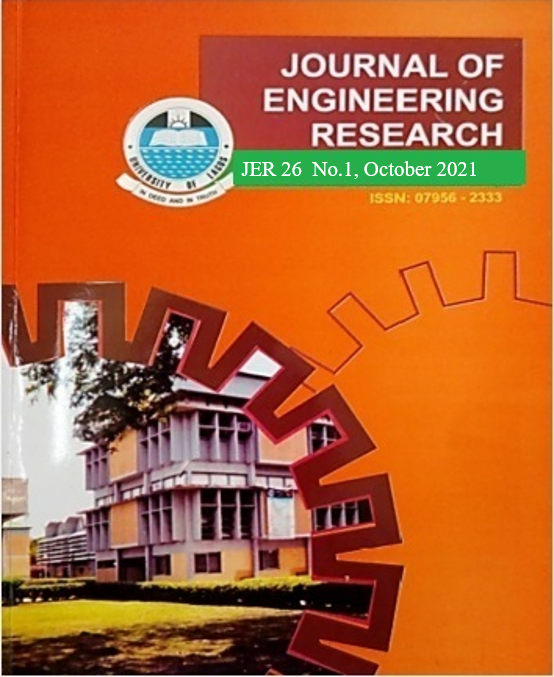Performance Evaluation of Selected Animal and Vegetable Oil Based Cutting Fluids in Mild Steel Turning Operation
Abstract
Mineral-based oils conventionally used as base oils in cutting fluids for mild steel turning operations are non-biodegradable and hazardous to human health. Alternative cutting fluids that will not present these difficulties needs to be developed. This study's goal was to assess how well cutting fluids made from vegetable and animal oils performed during mild steel turning operations. The sample fluids used were groundnut oil cutting fluid (GCF), palm kernel cutting fluid (PKCF), lard cutting fluid (LCF), tallow cutting fluid (TCF) and palm oil cutting fluid (POCF), while mineral oil-based cutting fluid (MCF) served as the control fluid. Different cutting speeds (34.88, 46.82, 62.84, 84.21) m/min; feed rates (0.20, 0.25, 0.30, 0.35) mm/rev and depths of cut (0.50, 1.00, 1.50, 2.00) mm were used in the turning operation. The parameters investigated were tool flank wear (Tw), spindle power ( ), machine vibration (Vm), noise (Nm), work piece surface roughness (Ra), and tool temperatures (T). From the results, MCF recorded average values of 0.21mm, 613.75W, 0.52 m/s2, 69.38dB, 1.14μm and 48.70oC for Tw, , Vm, Nm, Ra and T respectively, while the best performed sample fluid, LCF, recorded average values of 0.22mm, 602.50W, 0.52 m/s2, 69.40dB, 0.45μm and 48.90oC respectively. POCF was the least performed sample fluid, with average values of 0.28mm, 905.00W, 0.72 m/s2, 71.58dB, 1.62μm and 53.55oC for the above parameters, respectively. LCF recorded the closest values to MCF and this was followed by GCF, TCF, PKCF and POCF in that order respectively. The study showed that the investigated fluids offered competitive performance to that of MCF, hence, can serve as possible replacement for them.
References
Adegbuyi, P.A.O., Lawal, G., Oluseye, O. and Odunaiya, G. (2010). Analysing the effect of Cutting Fluids on the Mechanical Properties of Mild Steel in a Turning Operation. American Journal of Scientific and Industrial Research. 2 (1): 1-10.
Akpobi, J.A., and Enabulele, W.O. (2002). Formulation of a water-soluble oil as a metal cutting fluid. Nig. Inst. of Production Engineers Technical Transactions, Special Edition. 7(3),97-106.
Anyanwu B.U, Fadare D.A, Fayomi O.S.I., Aiyedun, P.O. and Agboola, O. (2020). Exploring the potential of animal fats and vegetable oils as potential metal cutting fluids. International Journal of Mechanical and Production Engineering Research and Development (IJMPERD). 10 (3): 1139-1146
Avila, R.F., and Abrao, A.M. (2001). The effect of cutting fluids on the machining of hardened AISI 4340 steel. J. Mater. Process. Technol. 119: 21–26.
Bartz, W. (2001). Ecological and Environmental Aspects of Cutting Fluids. Lubrication Engineering. 57: 13-16.
DeGarmo, E.P, Black J.T, Kosher R.A (1984). Materials and Processes in Manufacturing. Maxwell MacMillan Publication, (7th Edition) New York, USA. 578-581.
Glenn T.F and Antwerpen F Van (1998). Opportunities and market trends in metal working fluids. Lubrication Engineering. 54: 31-37.
Khan M.M.A, Mithu M.A.H and Dhar N.R (2009). Effects of minimum quantity lubrication on turning AISI 9310 alloy steel using vegetable oil-based cutting fluid. J. Mater. Process. Technol. 209: 5573–5583.
Kuram E, Ozcelik B, Demirbas E and Sik E (2010). Effects of the cutting fluid types and cutting parameters on surface roughness and thrust force. Proceedings of the WCE 2010, London, UK. Vol. II, June 30–July 2, 2010.
Krishna P, Vamsi R.R, Srikant .D, and Rao (2010). Experimental investigation on the performance of nanoboric acid suspensions in SAE-40 and coconut oil during turning of AISI 1040 steel. Int. J. Mach. Tool Manuf. 50: 911–916.
Lawal S.A, Choudhury I.A .and Nukman. Y (2011). Application of vegetable oil-based metal working fluids in machining ferrous metals—A review. International Journal of Machine Tools and Manufacture. 52: 1-12.
Sharif, S., Yusof N.M., Idris M.H., Ahmad Z.B., Sudin I., Ripin A., and MatZin M.A.H. (2009). Feasibility study of using vegetable oil as a cutting lubricant through the use of minimum quantity lubrication during machining. Research VOT No. 78055, Department of Manufacturing and Industrial Engineering, Faculty of Mechanical Engineering, Universiti Teknologi Malaysia. http://eprints.utm.my/9729/1/78055.pdfS.
Sreejith P.S and Ngoi B.K.A (2000). Dry machining; Machining of the future. Journal of Materials Processing Technology. 101: 287-291.


